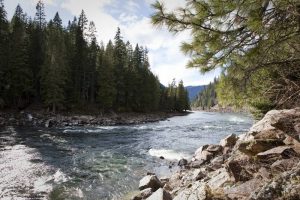
“Should you awaken at dawn on the banks of the Lochsa River to watch the sun creeping up the backsides of the Bitterroots, you will have found your welcome to Clearwater Country.”
– Clearwater Country! by Borg Hendrickson & Linwood Laughy
Much of the 20th Century laid witness to the industrial development of watersheds and rivers throughout the United States. The Bureau of Reclamation and the Army Corps of Engineers were damming and diverting rivers at an alarming rate. Things started to slowly change in the latter part of the century with the passage of public land laws, such as the 1968 Wild & Scenic Rivers Act. This historic legislation was a turning point in history because rivers and their immediate environments could now be protected under the law:
“It is hereby declared to be the policy of the United States that certain selected rivers of the Nation which, with their immediate environments, possess outstandingly remarkable scenic, recreational, geologic, fish and wildlife, historic, cultural, or other similar values, shall be preserved in free-flowing condition, and that they and their immediate environments shall be protected for the benefit and enjoyment of present and future generations.”
The Wild & Scenic Rivers Act established three different classifications for rivers protected under the law.
Wild: Rivers or sections of rivers free of impoundments and generally accessible by trail, with watersheds or shorelines essentially primitive and waters unpolluted.
Scenic: Rivers or sections of rivers free of impoundments, with shorelines or watersheds still largely primitive and undeveloped, but accessible in places by roads.
Recreation: Rivers or sections of rivers readily accessible by road or railroad, that may have some development along their shorelines, and may have undergone some impoundment or diversion in the past.
The Clearwater Basin contains three of the original eight rivers originally protected by the law.
Selway River
The headwaters of the most primitive river in the Lower 48 are located on the Bitterroot National Forest in the Frank Church-River of No Return Wilderness. The majority of the river, however, flows through the Selway-Bitterroot Wilderness on the Nez Perce National Forest. A large portion of the river is designated Wild, with a Recreation designation for the lower portion of the river. The Selway River canyon contains steep, rugged side slopes with a mixture of ponderosa pine, Douglas fir, and grand fir. The river contains crucial habitat for Bull trout and Chinook salmon. It also contains one of the last remaining strains of wild steelhead in the Lower 48 not affected by hatcheries. The Selway and Lochsa River confluence forms the Middle Fork Clearwater.
Lochsa River
The headwaters of this waterway are the Crooked Fork and Colt Killed Creek, which lie deep within the Bitterroot Range on the Clearwater National Forest. The river is designated Recreation from the Powell Ranger Station, west to its confluence with the Selway River, which forms the Middle Fork Clearwater. The Lochsa River canyon contains steep, rugged slide slopes with a mixture of Western red cedar, Douglas fir and grand fir. The river contains important habitat for Bull trout, steelhead and Chinook salmon. The Northwest Passage Scenic Byway parallels the river.
Middle Fork Clearwater River
The headwaters of the Middle Fork are the confluence of the Selway and Lochsa Rivers on the Clearwater National Forest. The section of river from Lowell, downstream to Kooskia, is designated Recreation. The river provides important habitat for Bull trout, steelhead and Chinook salmon. The Northwest Passage Scenic byway parallels this river, too. The lower Clearwater empties into the Lower Snake River at Lewiston, ID and Clarkston, WA. (Note the Lewis & Clark reference due to the historic expedition traveling through the area.)
There are also hundreds of miles of river segments in the Clearwater Basin that have been studied for designation, but have yet to receive the protection they deserve. Learn more.
The following rivers overlap with our mission area, and are protected under the Wild & Scenic Rivers Act.
Salmon River
This river flows mostly through the Frank Church-River of No Return Wilderness, with its headwaters located in central and eastern Idaho. The Salmon River has the longest stretch of free-flowing river (within one state) in the Lower 48. Flowing through one of the deepest gorges on the continent, this magnificent river contains Wild and Recreation segments, and offers outstanding values of scenery, recreation, geology, botany, fish, wildlife, water quality, and human history.
St. Joe River
Its headwaters are found deep in the Bitterroot Mountains on the St. Joe National Forest in North Idaho. From its beginnings at St. Joe Lake, the river is designated Wild for roughly twenty-six miles, and then Recreation, until being joined by the North Fork St. Joe. The river provides important habitat for Westslope cutthroat and Bull trout.